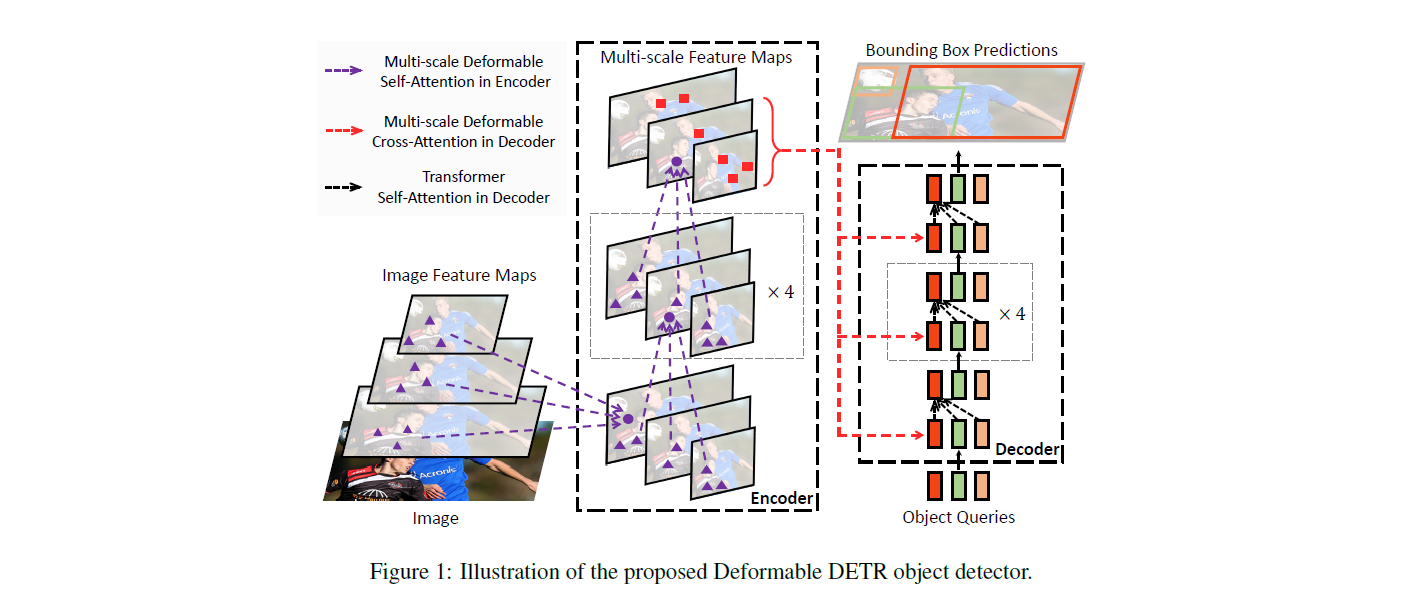File size: 4,610 Bytes
9e9a9e2 e381b9b 9e9a9e2 e381b9b 9e9a9e2 e381b9b 9e9a9e2 e381b9b 9e9a9e2 e381b9b 9e9a9e2 e381b9b 9e9a9e2 e381b9b 9e9a9e2 |
1 2 3 4 5 6 7 8 9 10 11 12 13 14 15 16 17 18 19 20 21 22 23 24 25 26 27 28 29 30 31 32 33 34 35 36 37 38 39 40 41 42 43 44 45 46 47 48 49 50 51 52 53 54 55 56 57 58 59 60 61 62 63 64 65 66 67 68 69 70 71 72 73 74 75 76 77 78 79 80 81 82 83 84 85 86 |
---
license: apache-2.0
tags:
- object-detection
- vision
datasets:
- coco
widget:
- src: https://huggingface.co/datasets/mishig/sample_images/resolve/main/savanna.jpg
example_title: Savanna
- src: https://huggingface.co/datasets/mishig/sample_images/resolve/main/football-match.jpg
example_title: Football Match
- src: https://huggingface.co/datasets/mishig/sample_images/resolve/main/airport.jpg
example_title: Airport
---
# Deformable DETR model with ResNet-50 backbone, with box refinement and two stage
Deformable DEtection TRansformer (DETR), with box refinement and two stage model trained end-to-end on COCO 2017 object detection (118k annotated images). It was introduced in the paper [Deformable DETR: Deformable Transformers for End-to-End Object Detection](https://arxiv.org/abs/2010.04159) by Zhu et al. and first released in [this repository](https://github.com/fundamentalvision/Deformable-DETR).
Disclaimer: The team releasing Deformable DETR did not write a model card for this model so this model card has been written by the Hugging Face team.
## Model description
The DETR model is an encoder-decoder transformer with a convolutional backbone. Two heads are added on top of the decoder outputs in order to perform object detection: a linear layer for the class labels and a MLP (multi-layer perceptron) for the bounding boxes. The model uses so-called object queries to detect objects in an image. Each object query looks for a particular object in the image. For COCO, the number of object queries is set to 100.
The model is trained using a "bipartite matching loss": one compares the predicted classes + bounding boxes of each of the N = 100 object queries to the ground truth annotations, padded up to the same length N (so if an image only contains 4 objects, 96 annotations will just have a "no object" as class and "no bounding box" as bounding box). The Hungarian matching algorithm is used to create an optimal one-to-one mapping between each of the N queries and each of the N annotations. Next, standard cross-entropy (for the classes) and a linear combination of the L1 and generalized IoU loss (for the bounding boxes) are used to optimize the parameters of the model.

## Intended uses & limitations
You can use the raw model for object detection. See the [model hub](https://huggingface.co/models?search=sensetime/deformable-detr) to look for all available Deformable DETR models.
### How to use
Here is how to use this model:
```python
from transformers import AutoImageProcessor, DeformableDetrForObjectDetection
import torch
from PIL import Image
import requests
url = "http://images.cocodataset.org/val2017/000000039769.jpg"
image = Image.open(requests.get(url, stream=True).raw)
processor = AutoImageProcessor.from_pretrained("SenseTime/deformable-detr-with-box-refine-two-stage")
model = DeformableDetrForObjectDetection.from_pretrained("SenseTime/deformable-detr-with-box-refine-two-stage")
inputs = processor(images=image, return_tensors="pt")
outputs = model(**inputs)
# convert outputs (bounding boxes and class logits) to COCO API
# let's only keep detections with score > 0.7
target_sizes = torch.tensor([image.size[::-1]])
results = processor.post_process_object_detection(outputs, target_sizes=target_sizes, threshold=0.7)[0]
for score, label, box in zip(results["scores"], results["labels"], results["boxes"]):
box = [round(i, 2) for i in box.tolist()]
print(
f"Detected {model.config.id2label[label.item()]} with confidence "
f"{round(score.item(), 3)} at location {box}"
)
```
Currently, both the feature extractor and model support PyTorch.
## Training data
The Deformable DETR model was trained on [COCO 2017 object detection](https://cocodataset.org/#download), a dataset consisting of 118k/5k annotated images for training/validation respectively.
### BibTeX entry and citation info
```bibtex
@misc{https://doi.org/10.48550/arxiv.2010.04159,
doi = {10.48550/ARXIV.2010.04159},
url = {https://arxiv.org/abs/2010.04159},
author = {Zhu, Xizhou and Su, Weijie and Lu, Lewei and Li, Bin and Wang, Xiaogang and Dai, Jifeng},
keywords = {Computer Vision and Pattern Recognition (cs.CV), FOS: Computer and information sciences, FOS: Computer and information sciences},
title = {Deformable DETR: Deformable Transformers for End-to-End Object Detection},
publisher = {arXiv},
year = {2020},
copyright = {arXiv.org perpetual, non-exclusive license}
}
``` |